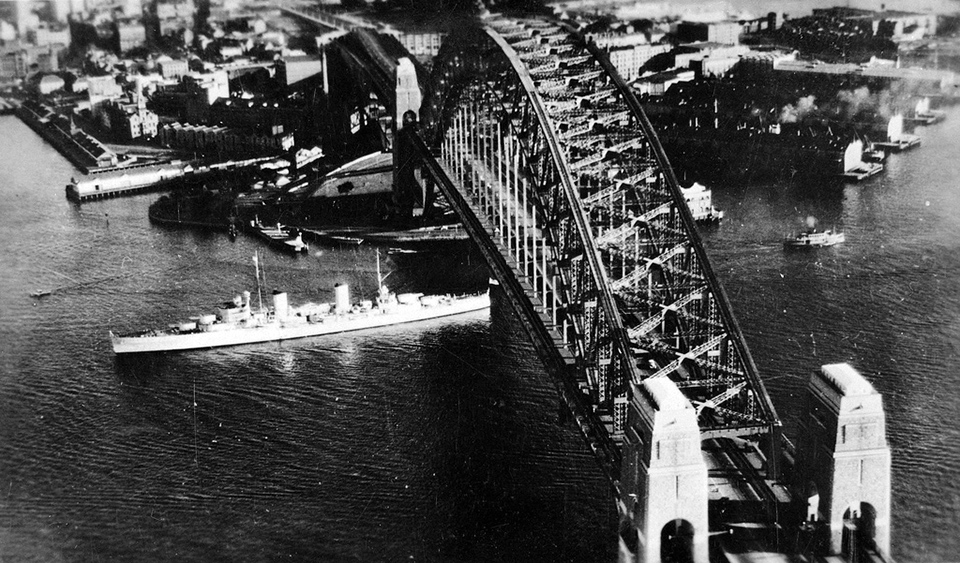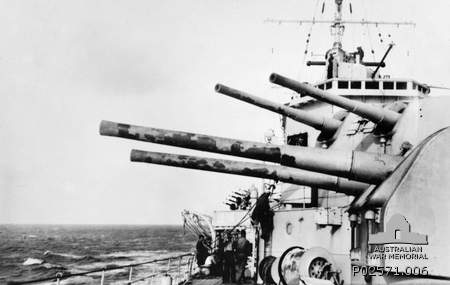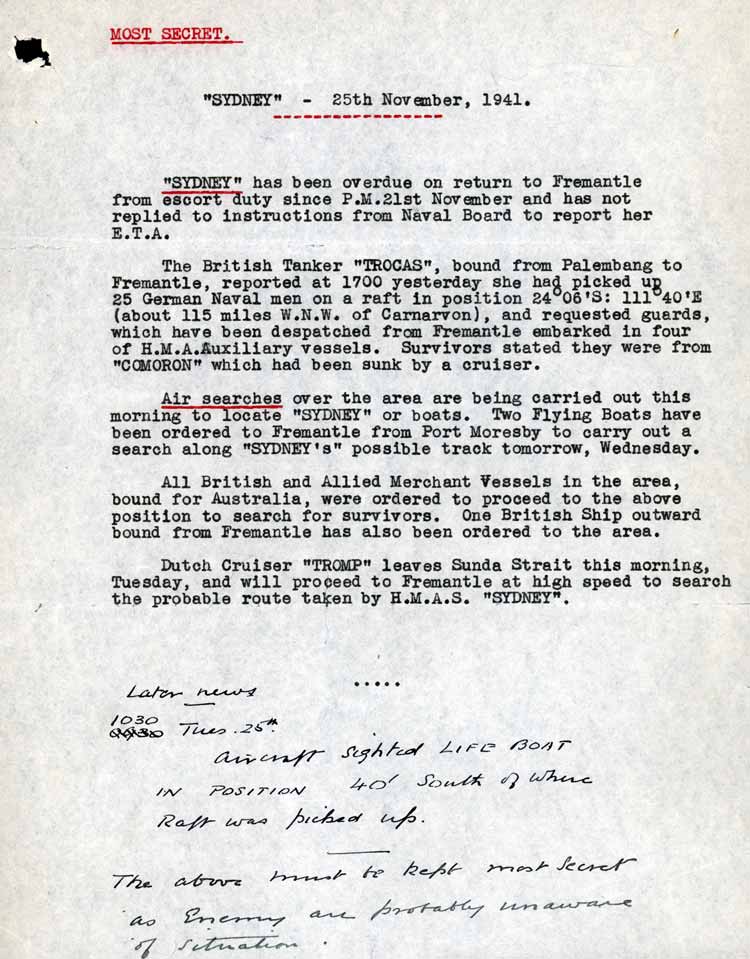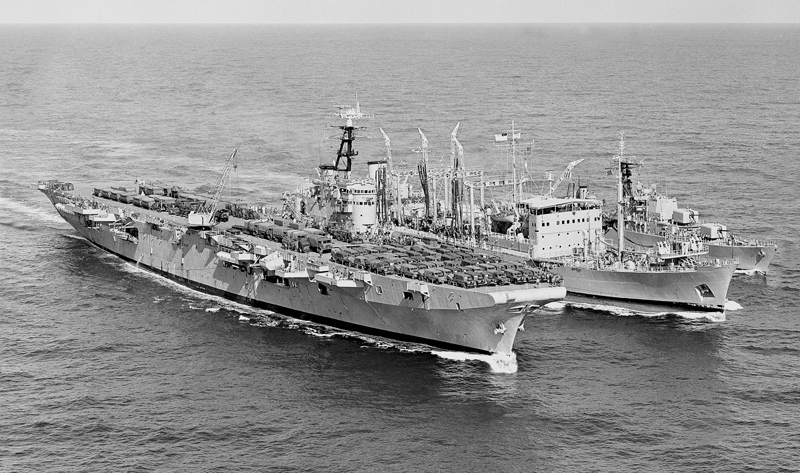The Dictionary of Sydney was archived in 2021.
HMAS Sydney
Citation
Persistent URL for this entry
To cite this entry in text
To cite this entry in a Wikipedia footnote citation
To cite this entry as a Wikipedia External link
HMAS Sydney
Sydney is the name given over the last century to four warships in the Royal Australian Navy, whose home base is the port city of Sydney.
The first HMAS Sydney
[media]Commissioned at Portsmouth on 26 June 1913, the ship left there a month later and arrived at the Australia Station (of the Royal Navy) in Albany, Western Australia, in September 1913.
Following a period spent in eastern Australian ports, in March 1914 it set out for Singapore as escort to two Royal Australian Navy submarines. After returning to Sydney, its 'home port', in May 1914, HMAS Sydney spent the remaining months of the pre-war period in Australian waters.
At the outbreak of war in August 1914, HMAS Sydney operated in New Guinea and Pacific waters, and in the brief campaign against the German Pacific possessions it aided in the capture of Rabaul between 9 [media]and 11 September 1914.
In October of that year, the Sydney returned to Australia, to form part of the escort of the first Anzac convoy, which consisted of 38 transports, escorted as well by HMS Minotaur and the Japanese cruiser Ibuki. Passing near the Cocos Islands at about 6.20 am on 9 November 1914, wireless telegraphy operators in several of the transports and warships heard signals in an unknown code. [media]As a precaution, Sydney, the nearest warship to the Cocos group, was ordered to proceed there at full speed. At 9.15 am the lookout sighted both the island and the German ship Emden, some seven or eight miles (11 or 12 kilometres) distant.
[media]The ships engaged, and in the ensuing battle the Emden suffered severe damage, and by 11 am it was aground on the North Keeling Island Reef. It lost 134 men, either killed in action or dying of wounds.
On 15 November 1914 Sydney arrived in Colombo, and from there was ordered to proceed to Malta where it arrived on 3 December. From Malta it went on to Bermuda to join the North America and West Indies Stations for patrol duty.
For the following 18 months, Sydney was engaged in watching neutral ports in the Americas, mainly in the West Indies, using Jamaica as a base, and off Long Island with Halifax as a base. It left Bermuda on 9 September 1916 and in October of that year it was temporarily attached to the 5th Battle Squadron at Scapa Flow.
[media]For the remainder of the war, its service was confined to routine North Sea patrols. In August 1917 Sydney underwent a three-month refit, during which it acquired its distinctive tripod mast, and was fitted with the first revolving aircraft launching platform to be installed in an Australian warship, put to good use in later engagements against the Germans in the North Sea area. HMAS Sydney was present at the surrender of the German Grand Fleet on 21 November 1918, and sailed from Portsmouth on 9 April 1919 for Sydney.
Except for visits to New Guinea in 1922 and New Caledonia and the Solomon Islands in 1927, Sydney spent the remainder of its career in home waters, serving as Flagship of the Australian Squadron from September 1924 to October 1927. It was decommissioned at Sydney on 8 May 1928, and on 10 January 1929 was delivered to the Cockatoo Island Dockyards for breaking up. Its tripod mast was removed and was installed across Sydney Harbour at Bradleys Head.
HMAS Sydney II
After being laid down in 1933 for the Royal Navy as HMS Phaeton, the warship was purchased by the Australian government in 1934 and renamed HMAS Sydney in memory of the earlier Sydney. It was commissioned at Portsmouth on 24 September 1935, under the command of a Royal Navy captain, and spent the early part of its career on the Mediterranean Station, taking an active role during the Abyssinian crisis.
[media]Finally arriving in Australia in August 1936, HMAS Sydney remained in home waters until the outbreak of World War II: it was in Fremantle on the day war was declared in 1939. On 16 November 1939 Captain JA Collins assumed command, and the ship remained on local patrol duties until April 1940 when it sailed from Fremantle as part of the escort for a large Middle East-bound convoy. Late in May 1940, it proceeded to the Mediterranean, arriving in Alexandria where it joined the 7th Cruiser Squadron of the Mediterranean Fleet.
Here Sydney experienced its first action, when it took part in the bombardment of Bardia in southern Italy on 21 June 1940. A week later, in company with other ships of the 7th Cruiser Squadron, HMAS Sydney encountered three Italian destroyers. Two of these destroyers succeeded in evading the Allied cruisers, and Sydney's role consisted chiefly of finishing off the remaining destroyer Espero and rescuing 47 Italian survivors.
On 1 July 1940 Sydney returned to Alexandria, and then proceeded, as part of the covering force, for Malta before joining the Mediterranean Battle Fleet. Following a period of severe air attacks, Sydney then took part in the first full-scale action against the Italian Fleet in the Battle of Calabria on 9 July.
Later that month, in company with the destroyer HMS Havock, Sydney sailed from Alexandria, to support destroyers engaged in a hunt for enemy submarines off Crete and to destroy enemy shipping in the Gulf of Athens. The two ships arrived off Crete, and passed through Kaso Strait shortly before midnight. [media]The next morning, at a point some 40 miles (64 kilometres) north of Cape Spada, they engaged with an Italian flotilla, which included the warships Bartolomeo Colleoni and Giovanni Delle Bande. In the ensuing battle, the Bartolomeo Colleoni and two Italian destroyers were sunk.
[media]After a refit in Malta in December1940, Sydney sailed from Alexandria for Australia, reaching Fremantle on 5 February 1941 where it received a hero's welcome. On arrival in Sydney on 10 February, the crew were fêted with a civic reception, and school children were given a public holiday to see the crew as they paraded through the city. A refit at Garden Island followed, after which the ship took up patrol and convoy escort duties off the Australian coast.
After visiting Singapore, Noumea, Auckland and Suva in its role as convoy escort, HMAS Sydney returned to Western Australian waters – and its destiny. It sailed from Fremantle on Armistice Day, 11 November 1941, to escort the troopship Zealandia to Sunda Strait. The voyage was without incident and at noon on 17 November Sydney began its trip back to Fremantle, where it was expected to arrive on the afternoon of 20 November 1941.
[media]But on 19 November, off the Western Australian coast, the Sydney encountered the German auxiliary cruiser Kormoran, disguised as the Dutch merchantman Straat Malakka. In the ensuing battle, Sydney was lost with all hands. The Kormoran was also sunk, although a total of 317 of its crew, including two Chinese, were rescued. The loss of Sydney, with its complement of 645 sailors, represented over a third of the Royal Australian Navy's casualties during World War II, the most grievous loss it ever suffered.
After decades of searching, the location of the wrecks of the Kormoran and the Sydney were discovered in March 2008: the Sydney lies on the seabed 2.5 kilometres down, about 100 nautical miles (185 kilometres) off the Western Australian coast, with the wreck of the Kormoran 12 nautical miles (22 kilometres) away. The area around them has been declared an official war grave site.
HMAS Sydney III
The third HMAS Sydney was the [media]first aircraft carrier of the Royal Australian Navy, and was initially built for the Royal Navy as HMS Terrible. It was commissioned at Devonport, England, on 16 December 1948, going into service early in February 1949. Following duties in Australian waters, Sydney returned to England in July 1950 to embark on two further exercises with naval air squadrons, and in September 1951 it became the carrier for the British naval forces in the Korean theatre.
This Sydney also has the distinction of being present at the Monte Bello Islands off Western Australia, when the first British atomic test took place on 3 October 1952. It remained in commission until 1958, conducting training cruises around the Australian coast and to New Zealand, and took part in one SEATO exercise in the western Pacific in September and October 1956.
Its role as an aircraft carrier ended when it was paid off into Special Reserve in Sydney on 30 May 1958, after steaming 315,958 miles (508,485 kilometres) since its commissioning. Then in March 1962, Sydney was recommissioned as a Fast Troop Transport, and after refitting in Sydney became operational in July 1963.
[media]Interspersed with training and exercise duties, the Sydney visited Vietnam, transporting troops and equipment, on 24 occasions, commencing in June 1965 and ending in February 1972, when the last Australian troops – except for a group of advisors – were withdrawn from Vietnam. HMAS Sydney arrived at its home port on 12 March.
A refit was planned, but in July 1973 the ship's company was informed that it had been decided to decommission the ship instead. On 28 October 1975 the ship was sold for scrap to Dongkuk Steel Mill Company Limited of Seoul, South Korea, and was towed out of Sydney Harbour on 23 December 1975.
By the time it was finally decommissioned in November 1973, the Sydney had steamed 711,549 miles (1,145,127 kilometres) since 1948, and had operated 'with distinction' in the Korean and Vietnam conflicts.
HMAS Sydney IV
[media]The current HMAS Sydney was launched on 26 September 1980, and commissioned on 29 January 1983. It is a guided missile frigate, with long-range escort capabilities, and has been deployed to the Middle East four times, taking part in Operation Desert Storm, the action against Iraq during the 1991 Gulf War. It was later used to support United Nations sanctions against Iraq in 1991 and 1992, and again in 1993.
In 1999 it was deployed to East Timor in support of the International Force for East Timor; and in 2000 it supported efforts to bring peace to the Solomon Islands. Its fourth deployment to the Middle East was during the height of the Iraq War, in 2003.
The fourth ship to carry this name is the proud inheritor of eight 'battle honours', more than any other vessel in the history of the Royal Australian Navy
Memorabilia
The City of Sydney holds in its collection a range of memorabilia relating to the various HMAS Sydneys. These include a bronze plaque commemorating the first Sydney's sinking of the German raider Emden (1914); a decanter in the shape of an artillery shell, featuring this Sydney (1916); a tinted photograph of HMAS Sydney off the Cocos Islands (1914); a photograph of the crew on board the second HMAS Sydney in 1940; an oil painting of the sinking by HMAS Sydney of the Italian cruiser Bartolomeo Colleoni (1940); a silver medallion commemorating this victory, presented to a crew member of the Sydney in 1941; a life buoy (c1948) from the third HMAS Sydney, presented to the City when the ship was decommissioned in 1973; and a plaque commemorating the actions of the third HMAS Sydney during the Vietnam conflict of 1965–1972 (1992). The four-inch gun from the German raider Emden is mounted in the south-east corner of Hyde Park in Sydney, pointing [media]up Oxford Street.
References
Royal Australian Navy website, 'HMAS Sydney', http://www.navy.gov.au/HMAS_Sydney, viewed 18 February 2009
M Betteridge, Sydney Town Hall: The Building and its Collection, City of Sydney Council, Sydney, 2008, pp 150–153















